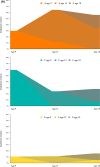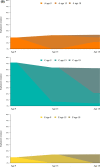The genetics of gaming: A longitudinal twin study
- PMID: 38054048
- PMCID: PMC10694538
- DOI: 10.1002/jcv2.12179
The genetics of gaming: A longitudinal twin study
Abstract
Background: Gaming is a popular past-time activity among children and adolescents, but it there is also a possible link to negative consequences such as psychological distress and lowered academic achievement. However, there are fundamental knowledge gaps remaining regarding central characteristics of gaming such as heritability, stability over time, and sex differences. We examined the genetic and environmental contribution to gaming behavior, including sex differences, continuity and change, in a longitudinal cohort of twins.
Methods: This is the first longitudinal twin study on gaming, involving 32,006 twins in Sweden. Parents were asked about the twins' gaming at ages 9, 15 and 18. We used univariate and multivariate twin analyses to estimate the relative contribution of genetic and environmental influences at each time-point as well as across time. Sex-differences were also explored.
Results: The results showed large sex differences, where genetics explained more of the variance for boys (31.3%-62.5% depending on age) than for girls (19.4%-23.4%). Genetic factors explained an increasing amount of the variance for boys (31.3% at age 9, 62.5% at age 15 and 53.9% at age 18). Shared environmental factors explained a larger proportion of the variance among girls, which remained relatively stable over time (70.5% at age 9, 61.8% at age 15 and 60.5% at age 18). The results also indicated that most of the variance came from genetic and environmental sources specific to each age.
Conclusions: Compared to many other behavioral phenotypes, such as gambling, gaming was relatively unstable with a large degree of genetic innovation. There were large sex differences in the contribution of genetic and environmental factors. This suggests that excessive gaming could be the result of age- and sex-specific genetic and environmental factors, and should be taken into account when mapping gaming behaviors, since these behaviors might be under continual etiological transformation.
Keywords: adolescence; gaming; heritability; twin studies.
© 2023 The Authors. JCPP Advances published by John Wiley & Sons Ltd on behalf of Association for Child and Adolescent Mental Health.
Conflict of interest statement
HL reports receiving grants from Shire Pharmaceuticals; personal fees from and serving as a speaker for Medice, Shire/Takeda Pharmaceuticals and Evolan Pharma AB; and sponsorship for a conference on attention‐deficit/hyperactivity disorder from Shire/Takeda Pharmaceuticals and Evolan Pharma AB, all outside the submitted work. He is also the Editor‐in‐chief of Journal of Child Psychology and Psychiatry Advances. PL serves on the JCPP Advances Editorial Advisory Board.
Figures



References
-
- Aarnio, M. , Winter, T. , Peltonen, J. , Kujala, U. , & Kaprio, J. (2002). Stability of leisure‐time physical activity during adolescence—A longitudinal study among 16‐, 17‐and 18‐year‐old Finnish youth. Scandinavian Journal of Medicine & Science in Sports, 12(3), 179–185. 10.1034/j.1600-0838.2002.00250.x - DOI - PubMed
-
- Aarseth, E. , Bean, A. M. , Boonen, H. , Colder Carras, M. , Coulson, M. , Das, D. , Deleuze, J. , Dunkels, E. , Edman, J. , Ferguson, C. J. , Haagsma, M. C. , Helmersson Bergmark, K. , Hussain, Z. , Jansz, J. , Kardefelt‐Winther, D. , Kutner, L. , Markey, P. , Nielsen, R. K. L. , Prause, N. , … Van Rooij, A. J. (2017). Scholars' open debate paper on the world health organization ICD‐11 gaming disorder proposal. Journal of Behavioral Addiction, 6(3), 267–270. 10.1556/2006.5.2016.088 - DOI - PMC - PubMed
-
- Anckarsäter, H. , Lundström, S. , Kollberg, L. , Kerekes, N. , Palm, C. , Carlström, E. , Långström, N. , Magnusson, P. K. , Halldner, L. , Bölte, S. , Gillberg, C. , Gumpert, C. , Råstam, M. , & Lichtenstein, P. (2011). The child and adolescent twin study in Sweden (CATSS). Twin Research and Human Genetics, 14(6), 495–508. 10.1375/twin.14.6.495 - DOI - PubMed
LinkOut - more resources
Full Text Sources
Miscellaneous
